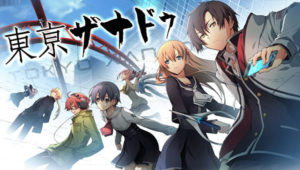 Chaos Rings III is a nice, colorful game with a simple story and pleasant characters. I have high hopes that it will be a great game once I get some better Genes and a higher MP cap. Right now, though, I just don’t feel like dealing with the magic restrictions and the resulting slow battles, so I’m shelving it for now. It’s not dropped-dropped, but don’t expect to see it here for a while.
Chaos Rings III is a nice, colorful game with a simple story and pleasant characters. I have high hopes that it will be a great game once I get some better Genes and a higher MP cap. Right now, though, I just don’t feel like dealing with the magic restrictions and the resulting slow battles, so I’m shelving it for now. It’s not dropped-dropped, but don’t expect to see it here for a while.
Instead I’ve been continuing Tokyo Xanadu eX+, which I started late last year but only recently got serious about. As I said in my initial post on the game, it’s a lot of fun but not the action RPG I was looking for. Instead it’s definitely a Majin-like, the criteria for which are the following:
– Ratio of 90% visual novel to 10% gameplay (Tokyo Xanadu eX+ only goes up to 80-20 if you include optional sidequests).
– Heavy focus on the occult/supernatural.
– Cast skewed heavily towards high school students who do typical anime high schooler stuff. We haven’t had a school festival or a beach/hot spring episode yet, but it’s only a matter of time.
Since I have now accepted that Tokyo Xanadu eX+ is not an ARPG but a visual novel with action combat, this is the last time I will comment on the issue. I will just take the game as it comes. After all, I am enjoying the parts where I roam around town talking to people. Every once in a while you learn something new about a character and get an updated entry in the glossary, which is fun in its own way.
It’s just that if you treat the game as a VN then you start evaluating it by story, characters, dialogue instead of by gameplay, controls, challenge, etc. How does Tokyo Xanadu hold up?
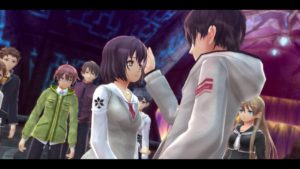 Story: Reminds me a lot of Persona 4, where you have this alternate dimension that people get thrown/drawn into and if you don’t save them quickly they’ll die. But this time our team always gets there in the nick of time – no matter how long we dilly-dally we’ll always get there juuust before the boss attacks the victim. I don’t know how we do it ^_~.
Story: Reminds me a lot of Persona 4, where you have this alternate dimension that people get thrown/drawn into and if you don’t save them quickly they’ll die. But this time our team always gets there in the nick of time – no matter how long we dilly-dally we’ll always get there juuust before the boss attacks the victim. I don’t know how we do it ^_~.
But that’s more like the flow of the game. The real story, i.e. why those dimensions/Eclipses are appearing and what we can do to get at the root of the issue, well after 16 hours and 30 minutes of playing I haven’t gotten one whit closer to an answer. That’s normal for Falcom games though. Waste the first two-thirds of the game with fetchquests and “world building” and then shove the story in hurriedly in the last third of the game.
I wouldn’t be annoyed if it wasn’t for the fact that a lot of characters seem to know what’s going on, or at least have a better idea than the main character does but they’re not sharing anything. Kou Tokisaka is not making much effort to get answers either, but the others are definitely blocking him – and by the extension, the player – from getting to the meat of the story until Falcom is good and ready.
That’s why Kou never asks about the history of Nemesis or of the Eclipses from any of the many shopkeepers who somehow handle Eclipse goods. That’s why he’s stupid enough to actively ignore heavy hints from people like Mitsuki and the antique shop owner. Actively and energetically ignore – often the evidence is right in front of his face and he’s like “Nah, it couldn’t be!” It could be! It IS! You numbskull! Oh Kou, Kou, what am I going to do with you? *shakes head*
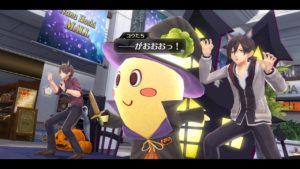 Characters: Harmless enough. The high school students are good kids to the point of ridiculousness. Like they’ll beat each other to a pulp one day and the next day they’re the closest buddies ever. Yeah, okay. Even the usual “girl-crazy friend of the protagonist who envies his luck with girls” is more wholesome than such characters usually are and hasn’t once tried to peek in the girls’ locker room. That’s real progress.
Characters: Harmless enough. The high school students are good kids to the point of ridiculousness. Like they’ll beat each other to a pulp one day and the next day they’re the closest buddies ever. Yeah, okay. Even the usual “girl-crazy friend of the protagonist who envies his luck with girls” is more wholesome than such characters usually are and hasn’t once tried to peek in the girls’ locker room. That’s real progress.
The only issue with all this fluffy wholesomeness, if you can call it an issue, is that there’s zero room for doubt about how things will turn out in the end. You know every conflict and problem is going to end well, lots of hugs and tears and “Believe in me who believes in you” talk. Everyone lives happily ever after and repercussions are kept to a minimum. Tension is zero so the story isn’t that interesting. Or maybe it’s just the evil side of me talking. And knowing Falcom, something horrible is bound to happen to Morimiya City towards the end of the game so there’s hope yet!
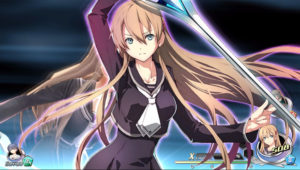 Everything else that comes to mind: The loading times are a bit long. Probably just my laptop being weaksauce, but it makes exploration suck when you have to wait 15-20 seconds every time you enter or leave a room, a shop or a floor. Note to self: do all future PC gaming on more powerful desktop.
Everything else that comes to mind: The loading times are a bit long. Probably just my laptop being weaksauce, but it makes exploration suck when you have to wait 15-20 seconds every time you enter or leave a room, a shop or a floor. Note to self: do all future PC gaming on more powerful desktop.
I have 5 playable characters so far, but no one’s as fun to control as Kou and Asuka. What I don’t get is why they can’t both go into battle at the same time. Where is the other one hiding? And why? I don’t know when I’ll ever get used to the “I’m here, but I’m not gonna help” nature of party members in most RPGs, but usually it doesn’t stand out as badly as it does in Tokyo Xanadu eX+ because you have a whole team of party members. Here it’s only one (visible) person doing everything so it feels really weird.
Other comments on the battle system will have to wait until I’m doing with the game, seeing as it isn’t really an ARPG and all. That will be enough time for me to get used to certain things and for others to improve. For example, right now I’m not pleased by how little equipment there is in the game or how there are so many accessories with little to distinguish them from each other. But that might change. The same goes for the useless(?) grid system with its hopelessly weak power-ups. I might get super rare jewels later on that will turn the whole game around.
That’s enough for an early-stage comment on Tokyo Xanadu eX+. Falcom’s games are usually 40-60 hours long, so 16 hours isn’t even halfway through. I’ll be back with an update at the 30-hour mark and maybe 45 hours if I make it in that far. I’m starting to crave something new, though. Might revisit DQ7 or something, we’ll see.

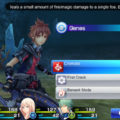
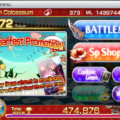
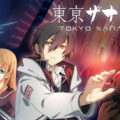
I started Tokyo Xanadu on the Vita a couple of months ago, hoping for a kickass ARPG; and I dropped it after realizing that it was, as you rightly said, a VN/high school simulator with bits of fighting in between. I’ll probably pick it up again when I’m in the mood for that type of game, if only to recoup my investment… Although to be honest, I cannot help but think that Nihon Falcom wasted a perfectly good fighting system here. Combat in TX is incredibly well-handled and satisfying, and I would have wished for a reverse ratio between fighting segments and VN segments.
Same here. The ratio does seem to be picking up a bit after 20 hours though, and I finally got an explanation of what’s going on. Better than nothing!
Good thing that I didn’t buy it yet!
Thanks for the review
Oh, well, Chaos Rings III is not that bad. I said I dropped it, but I still play an hour here and there once in a while. There are way better games out there, though.